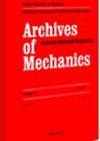Modeling Gum Metal and other newly developed titanium alloys within a new class of constitutive relations for elastic bodies
IF 1.2
4区 工程技术
Q3 MATERIALS SCIENCE, CHARACTERIZATION & TESTING
引用次数: 23
Abstract
Many titanium alloys and even materials such as concrete exhibit a nonlinear relationship between strain and stress, when the strain is small enough that the square of the norm of the displacement gradient can be ignored in comparison to the norm of the displacement gradient. Such response cannot be described within the classical theory of Cauchy elasticity wherein a linearization of the nonlinear strain leads to the classical linearized elastic response. A new framework for elasticity has been put into place in which one can justify rigorously a nonlinear relationship between the linearized strain and stress. Here, we consider one such model based on a power-law relationship. Previous attempts at describing such response have been either limited to the response of one particular material, e.g. Gum Metal, or involved a model with more material moduli, than the model considered in this work. For the uniaxial response of several metallic alloys, the model that is being considered fits experimental data exceedingly well.在一类新的弹性体本构关系中模拟胶金属和其他新开发的钛合金
当应变小到与位移梯度的范数相比可以忽略位移梯度的范的平方时,许多钛合金甚至诸如混凝土的材料在应变和应力之间表现出非线性关系。这种响应不能在柯西弹性的经典理论中描述,其中非线性应变的线性化导致经典的线性化弹性响应。一个新的弹性框架已经建立起来,在这个框架中,人们可以严格证明线性应变和应力之间的非线性关系。在这里,我们考虑一个基于幂律关系的这样的模型。以前描述这种响应的尝试要么局限于一种特定材料的响应,例如口香糖金属,要么涉及比本工作中考虑的模型具有更多材料模量的模型。对于几种金属合金的单轴响应,所考虑的模型与实验数据非常吻合。
本文章由计算机程序翻译,如有差异,请以英文原文为准。
求助全文
约1分钟内获得全文
求助全文
来源期刊

Archives of Mechanics
工程技术-材料科学:表征与测试
CiteScore
1.40
自引率
12.50%
发文量
0
审稿时长
>12 weeks
期刊介绍:
Archives of Mechanics provides a forum for original research on mechanics of solids, fluids and discrete systems, including the development of mathematical methods for solving mechanical problems. The journal encompasses all aspects of the field, with the emphasis placed on:
-mechanics of materials: elasticity, plasticity, time-dependent phenomena, phase transformation, damage, fracture; physical and experimental foundations, micromechanics, thermodynamics, instabilities;
-methods and problems in continuum mechanics: general theory and novel applications, thermomechanics, structural analysis, porous media, contact problems;
-dynamics of material systems;
-fluid flows and interactions with solids.
Papers published in the Archives should contain original contributions dealing with theoretical, experimental, or numerical aspects of mechanical problems listed above.
The journal publishes also current announcements and information about important scientific events of possible interest to its readers, like conferences, congresses, symposia, work-shops, courses, etc.
Occasionally, special issues of the journal may be devoted to publication of all or selected papers presented at international conferences or other scientific meetings. However, all papers intended for such an issue are subjected to the usual reviewing and acceptance procedure.
 求助内容:
求助内容: 应助结果提醒方式:
应助结果提醒方式:


